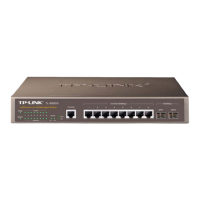143
and permit means forwarding packets. By default, the option is permit.
source-ip —— The source IP address contained in the rule.
source-ip-mask —— The source IP address mask. It is required if you typed
the source IP address.
destination-ip —— The destination IP address contained in the rule.
destination-ip-mask —— The destination IP address mask. It is required if you
typed the destination IP address.
time-segment —— The time-range for the rule to take effect. By default, it is
not limited.
Command Mode
Global Configuration Mode
Example
Create a Standard-IP ACL whose ID is 120, and add Rule 10 for it. In the rule,
the source IP address is 192.168.0.100, the source IP address mask is
255.255.255.0, the time-range for the rule to take effect is tSeg1, and the
packets match this rule will be forwarded by the switch:
TP-LINK(config)# acl create 120
TP-LINK(config)# acl rule std-acl 120 10 op permit dip 192.168.0.100 dmask
255.255.255.0 tseg tSeg1
acl edit rule std-acl
Description
The acl edit rule std-acl command is used to edit Standard-IP ACL rule.
Syntax
acl edit rule std-acl {acl-id} {rule-id} [op {discard | permit}] [[sip source-ip]
{smask source-ip-mask}] [[dip destination-ip] {dmask destination-ip-mask}]
[tseg time-segment] [index idx]
Parameter
acl-id —— The desired Standard-IP ACL for configuration.
rule-id —— The rule ID.
op —— The operation for the switch to process packets which match the rules.
There are two options, discard and permit. Discard means discarding packets,
and permit means forwarding packets. By default, the option is permit.
source-ip —— The source IP address contained in the rule.

